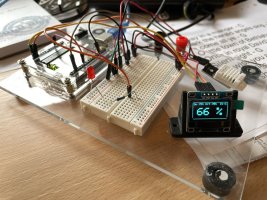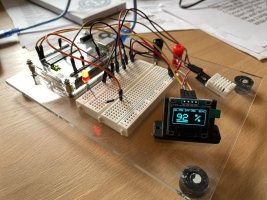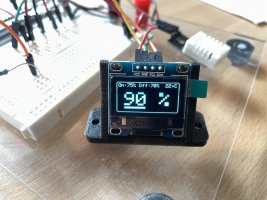Hi. I work in creative tech and have an engineering degree. I’m currently planning my second conversion, and am determined to have a crack at a smart system to better control condensation. There’s a very affordable system called Arduino - a small microprocessor that you can connect a wide range of sensors to, and control external kit with, based on coded bespoke algorithms. Arduino accepts 12v dc as a power supply and the box is no bigger than a fag packet so can sit just about anywhere behind panels or in cupboards and draw a very low amount of power off the leisure battery. There are temperature sensors and relative humidity sensors that cost a couple of quid. They’re really cheap - a complete system would cost no more than £20 if you shop around. First place I’m going to look is to control an extractor fan based on an RH reading, but the options are there for temp sensing too, so dew point calcs are possible. If anyone would like to join in on the journey (especially if you’re an HVAC engineer!) then please do chip in here. I’ve got a coder on staff at work who’ll help if the code gets complex. If nobody’s game I’ll still post the results here. I’m expecting to fail but learn something useful in the process for V2. Whatever the results I’d share them here along with code - I’m not looking to make a product, I’ve more of an open source approach. 
You are using an out of date browser. It may not display this or other websites correctly.
You should upgrade or use an alternative browser.
You should upgrade or use an alternative browser.
Idea forming: Using an Arduino Microcontroller and sensors to *try* and combat condensation
- Thread starter CJW
- Start date
-
- Tags
- condensation
Just buy a fan with a humidity sensor built in - I have one in my wetroom at home so I should think that there is a 12v one on the market already.
Fan, heater, dehumidifier...
Whatever you plan on using your Arduino smarts to run, power is normally your problem.
Dehumidifiers use compressors or peltier elements which are power hungry, as are fans and heaters..... So whatever route you choose 12v battery power and capacity is always the stumbling block.
You can run a dehumidifier in the van to remove moisture..... But it will kill a van battery in a few hours......
Just adding more info to your cause and eager to see what you come up with.
Good luck with V1.
.
Whatever you plan on using your Arduino smarts to run, power is normally your problem.
Dehumidifiers use compressors or peltier elements which are power hungry, as are fans and heaters..... So whatever route you choose 12v battery power and capacity is always the stumbling block.
You can run a dehumidifier in the van to remove moisture..... But it will kill a van battery in a few hours......
Just adding more info to your cause and eager to see what you come up with.
Good luck with V1.
.
Hi. Yes, that’s what gave me the idea - the shower at work has one, but it’s very noisy. Taking the same principle and choosing a very quiet fan (one from a PC I’m thinking) and being more sensitive to power I.e. reading power levels from the battery would both help create a better suited product. Maybe I’ll get a 12v version of the wet room one as a comparison.Just buy a fan with a humidity sensor built in - I have one in my wetroom at home so I should think that there is a 12v one on the market already.
Thank you! I was thinking about reading the voltage on the leisure battery and tailoring power usage to suit - full battery = full performance, Depleted battery = little or no function. I’ll have a look at power consumption of small dc PC fans.Fan, heater, dehumidifier...
Whatever you plan on using your Arduino smarts to run, power is normally your problem.
Dehumidifiers use compressors or peltier elements which are power hungry, as are fans and heaters..... So whatever route you choose 12v battery power and capacity is always the stumbling block.
You can run a dehumidifier in the van to remove moisture..... But it will kill a van battery in a few hours......
Just adding more info to your cause and eager to see what you come up with.
Good luck with V1.
.
Agreed extraction can’t work when incoming air is just as humid.But at this time of year the external air will be moisture saturated which sort of defeats the fan only option. Check daily humidity levels and see where I’m coming from.
This fan is only 0.08A at 12v at full tilt of 800rpm giving 84 cubic feet / min. Could be fitted to an off-the-shelf extractor cowl. I’ll get one and see if it’s true.Fan, heater, dehumidifier...
Whatever you plan on using your Arduino smarts to run, power is normally your problem.
Dehumidifiers use compressors or peltier elements which are power hungry, as are fans and heaters..... So whatever route you choose 12v battery power and capacity is always the stumbling block.
You can run a dehumidifier in the van to remove moisture..... But it will kill a van battery in a few hours......
Just adding more info to your cause and eager to see what you come up with.
Good luck with V1.
.
NF-A20 PWM chromax.black.swap 12V 800RPM 200mm Premium Quality Fan
Noctua's NF-A20 are extremely popular fan and now it is available in an all black model. This fan is crammed with all of their expertise to make an exceptionally quiet 200mm PWM fan.
I used this in my vent. I run it when using the hob and all night with negligible draw on my leisure battery.
Your end game sensors are
The simplest algorithm is that condensation potential is proportional to the delta between internal dew point and external temperature. Primary factors affecting the rate are R value of the skin mixing of the internal air, and outside wind velocity. Total condensation potential is integrated over the time that the delta is negative.
Any air vented is assumed to be replaced by ambient air which is potentially saturated. This can still be beneficial because the internal dew point will tend towards the external dew point. You can use your microprocessor to calculate the delta dew point per watt and choose a cut off.
It would be nice to see your work published somewhere where others might benefit from, or improve on, it.
- external temperature.
- internal dew point.
The simplest algorithm is that condensation potential is proportional to the delta between internal dew point and external temperature. Primary factors affecting the rate are R value of the skin mixing of the internal air, and outside wind velocity. Total condensation potential is integrated over the time that the delta is negative.
Any air vented is assumed to be replaced by ambient air which is potentially saturated. This can still be beneficial because the internal dew point will tend towards the external dew point. You can use your microprocessor to calculate the delta dew point per watt and choose a cut off.
It would be nice to see your work published somewhere where others might benefit from, or improve on, it.
Ok, so I happened to have an Arduino attached to a humidity/temperature sensor and a small OLED display, as I have been looking at making a combined voltage/temp/humidity sensor for the van. So with a bit of fiddling we have the following:

Display shows current humidity, and I added the switch on / switch off parameters plus the current temp.
Red LED is off showing circuit has not triggered.
Next photo shows circuit triggering due to 92% humidity (I breathed on the sensor a few times).

Red LED is on (clearly this could be a relay or MOSFET switch). The underline under the humidity number is just to show that the circuit has triggered).
Close-up of OLED display (some flicker effect with the camera).

It’s a start !
Pete

Display shows current humidity, and I added the switch on / switch off parameters plus the current temp.
Red LED is off showing circuit has not triggered.
Next photo shows circuit triggering due to 92% humidity (I breathed on the sensor a few times).

Red LED is on (clearly this could be a relay or MOSFET switch). The underline under the humidity number is just to show that the circuit has triggered).
Close-up of OLED display (some flicker effect with the camera).

It’s a start !
Pete
And a very good start too!Ok, so I happened to have an Arduino attached to a humidity/temperature sensor and a small OLED display, as I have been looking at making a combined voltage/temp/humidity sensor for the van. So with a bit of fiddling we have the following:
View attachment 139911
Display shows current humidity, and I added the switch on / switch off parameters plus the current temp.
Red LED is off showing circuit has not triggered.
Next photo shows circuit triggering due to 92% humidity (I breathed on the sensor a few times).
View attachment 139912
Red LED is on (clearly this could be a relay or MOSFET switch). The underline under the humidity number is just to show that the circuit has triggered).
Close-up of OLED display (some flicker effect with the camera).
View attachment 139913
It’s a start !
Pete
Similar threads
- Replies
- 6
- Views
- 3K
- Replies
- 28
- Views
- 50K
- Sticky
- Replies
- 18
- Views
- 19K
- Replies
- 3
- Views
- 3K
